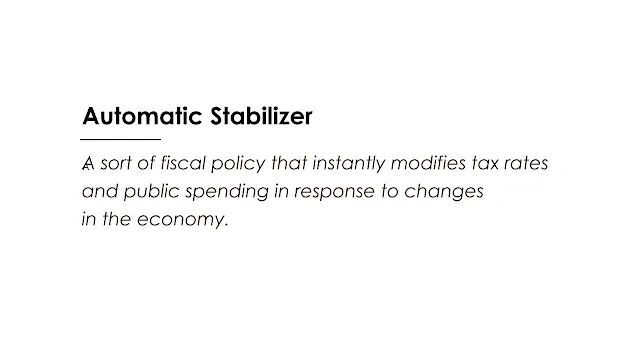 |
| Image: Moneybestpal.com |
An automatic stabilizer is a sort of fiscal policy that instantly modifies tax rates and public spending in response to changes in the economy. Without the need for more government or policymaker action, it is intended to reduce business cycle swings and stabilize the economy.
The idea behind automatic stabilizers is countercyclical fiscal policy, in which the government intervenes in the opposite direction of the economy. When the economy is growing, the government raises more revenue and spends less, which results in a budget surplus and lessens the pressure on inflation. In a downturn, the government collects fewer taxes and spends more, which leads to a budget deficit and increases aggregate demand.
The main automatic stabilizers are:
- Progressive income tax: In a progressive income tax system, the tax rate rises in proportion to income. Accordingly, high incomes result in more tax payments and lower disposable income, which lowers consumption and inflation. Low earnings result in lower tax burdens and higher disposable income, which boosts output and consumption.
- Corporate income tax: A corporate income tax system is one in which a company's profits determine the tax rate. This translates to higher tax payments and fewer retained earnings for investment when profits are high, which inhibits investment and growth. When profits are low, businesses pay fewer taxes and have more money left over to invest, which boosts spending and production.
- Transfer payments: Transfer payments are sums of money that the government gives to people or organizations without expecting anything in return, such as products or services. Unemployment compensation, welfare benefits, social security pensions, etc. are some examples of transfer payments. Transfer payments function as automatic stabilizers since they rise during economic downturns and fall during expansions. This means that when unemployment is high, people receive more benefits and have more money to spend, which increases productivity and consumption. People receive fewer benefits and have less money to spend when unemployment is low, which affects productivity and consumption.
The advantages of automatic stabilizers are:
- Timely: The implementation of automatic stabilizers does not call for legislative authorization or administrative delay. Changes in economic indicators like income, profitability, unemployment, etc. automatically set them off. They are therefore quicker and more efficient than discretionary fiscal policy, which entails the government or policymakers making conscious adjustments to tax rates or government spending.
- Predictable: Automatic stabilizers are based on established rules and formulas that the public and private sectors are aware of beforehand. As a result, there is less uncertainty and more economic confidence. Additionally, it enables both public and commercial organizations to plan and budget more effectively.
- Self-correcting: Automatic stabilizers function in both directions of the business cycle, increasing or decreasing based on the state of the economy. By doing this, they are guaranteed not to produce ongoing budget deficits or surpluses that may endanger the government's capacity to maintain its fiscal stability.
The disadvantages of automatic stabilizers are:
- Limited: Economic shocks cannot entirely be eliminated, only their effects can be softened by automatic stabilizers. It's possible that they won't be enough to address major crises or recessions that call for more drastic fiscal stimulus or austerity measures. Additionally, they may not be successful in addressing systemic issues or long-term difficulties that call for structural changes or substantial investments.
- Rigid: Automatic stabilizers are built on set rules and formulas that might not take into account the shifting demands and preferences of society or the economy. They might not be able to change with the times or respond more nimbly or creatively to new situations. The way resources are allocated or incentive structures may also become inefficient or distorted as a result.
- Costly: Increased taxation and expenditure by the government are implied by automatic stabilizers, and both factors could be detrimental to economic efficiency and expansion. Increased expenditure could crowd out private sector activity, lead to dependency issues, or generate moral hazard issues, while higher taxes could limit incentives to work, save, invest, or innovate.
In summary, a fiscal policy known as an automatic stabilizer automatically modifies tax rates and public spending in response to changes in economic conditions. It is made to stabilize the economy and smooth out business cycle swings without the need for extra government or policymaker intervention. It has benefits like timeliness, predictability, and self-correction, but it also has drawbacks like rigidity, cost, and limitation.
